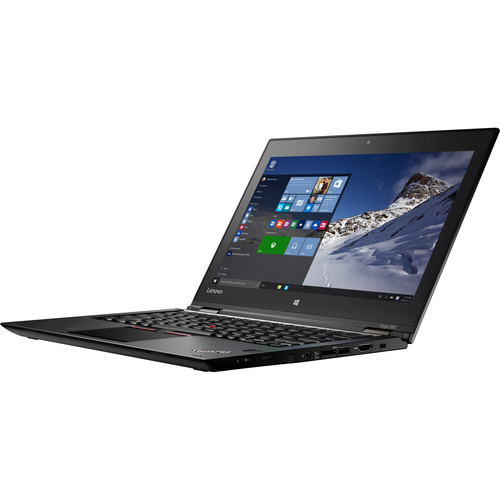Description
Lenovo Yoga 260 Overview
With a 360∞ hinge, the Lenovo 12.5″ ThinkPad Yoga 260 Multi-Touch 2-in-1 Notebook can be used in a variety of modes, including laptop, tent, stand, and tablet modes.
The 12.5″ display features an HD 1366 x 768 resolution, a 16:9 aspect ratio, 300 nits of brightness, and an IPS panel for wider viewing angles. The screen also has an anti-glare coating for reduced glare. Visuals are handled by the integrated Intel HD Graphics 520 and the video can be extended to an external display via the HDMI port.
The system is powered by a 6th Gen Skylake Intel Core i5-6300U dual-core processor. It also has 8GB of DDR4 RAM, a 256GB solid-state drive, 802.11ac Wi-Fi, Bluetooth, and USB 3.1 Gen 1 Type-A. A ThinkPad Pen Pro is included.
Windows 10 Pro is the installed operating system. The Pro version of Windows 10 includes all of the features of Windows 10 Home plus many designed specifically for business users, including Hyper-V virtualization, BitLocker disk encryption, and remote desktop access. Devices will also be able to join domains and the Azure Active Directory, and they can even access a specialized version of the Windows Store featuring custom, company-specific applications.
Lenovo ThinkPad Yoga 260
6th Gen Skylake Intel Core i5 Performance
This Lenovo computer houses a 6th Gen Skylake Intel Core i5-6300U processor. Its dual cores can reach a stock speed of 2.4 GHz and can be boosted up to 3.0 GHz.
12.5″ HD Multi-Touch Display
The 12.5″ display features a HD 1366 x 768 resolution, a 16:9 aspect ratio, and 300 nits of brightness. The screen also has 10-point multi-touch support. The screen features in-plane switching (IPS) technology for wider viewing angles and an anti-glare coating.
360∞ Hinge
The 360∞ hinge allows you to use the Lenovo ThinkPad Yoga 260 in a variety of modes, including laptop, tent, stand, and tablet.
Windows 10 Pro
Start Menu
After its hiatus in Windows 8, the Start Menu has returned. Utilizing a combination of the traditional menu system and Windows 8’s Live Tiles, the improved Start Menu gives you more information at a glance, showing notification information alongside your applications and other pinned items.
Cortana
Microsoft’s digital personal assistant, Cortana can answer your questions with information gleaned from both your device and the internet at large. You can type or even talk with her, if your system has a microphone. Using her Notebook, Cortana keeps track of your needs and wants, and she learns over time to improve her information gathering skills.
Microsoft Edge
After nearly 20 years, Microsoft has finally replaced its Internet Explorer web browser. With Microsoft Edge, users can write directly on web pages and share notes with friends and colleagues. It also improves the online reading experience by adding a distraction-free mode and read-it-later functionality. Edge also has built-in Cortana integration; you can have her help you find a restaurant, make a reservation, and pull up directions without leaving your browser.
Windows Store
For Windows 10, Microsoft has unified the Windows Store. Now, apps for PCs, tablets, and phones will all be accessible from one place. And with support for Universal Apps, one version of an app can work across all your compatible devices automatically.
Windows Continuum
Windows 10 was designed for a variety of screen sizes and input styles, and with its Continuum feature, it automatically adapts to fit your needs. A Windows 10 tablet on its own requires a touch-centric approach, but attaching a mouse and keyboard will shift everything to a more traditional interface. You can even attach an external monitor to your Windows 10 phone for a near-desktop experience. But it’s not just the operating system; Windows Universal Apps take advantage of Continuum as well.
Xbox on Windows 10
Gaming is a big focus of Windows 10. Xbox integration allows for PC players to match up against Xbox One players on supported games, and if you have an Xbox One, you can even stream compatible titles to your PC. Native support for recording with the new Game DVR feature makes it easy to capture and share your gameplay. The new DirectX12 takes better advantage of multi-core processors, giving games a performance boost, even on older hardware. Windows 10 also features native support for virtual reality headsets, such as the Oculus Rift.





















